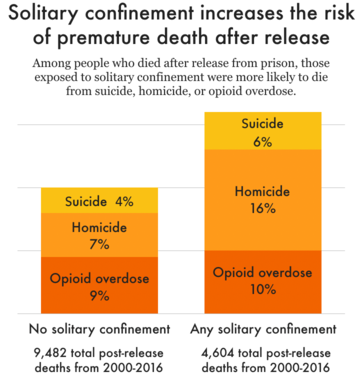The research is clear: Solitary confinement causes long-lasting harm
At the International Symposium on Solitary Confinement, researchers and formerly incarcerated people made it clear that isolation causes severe and permanent damage.
by Tiana Herring, December 8, 2020
On a given day last year, an estimated 55,000 to 62,500 people had spent the previous 15 days in solitary confinement in state and federal prisons, often in cells smaller than a parking space.1 Correctional officials often defend their frequent use of solitary confinement as an effective means of maintaining order and deterring violence and gang activity. But this reliance on solitary ignores the abundance of studies demonstrating the harmful and often long-lasting effects it wreaks on the human mind and body.
At the International Symposium on Solitary Confinement, sponsored by Thomas Jefferson University in November, researchers and formerly incarcerated people made it clear that any “positive” benefits correctional institutions gain by using solitary confinement are outweighed by the severe and often permanent damages caused by prolonged isolation. Recent studies show that time spent in solitary confinement shortens lives, even after release, and speakers at the International Symposium emphasized various other ways solitary causes irreparable harm.
Solitary confinement goes by many names, including “special housing units,” “administrative segregation,” “disciplinary segregation,” and “restrictive housing,” but the conditions are generally the same: 22 to 24 hours per day spent alone in a small cell.2 The practice is widespread in jails, prisons, ICE detention centers, and juvenile facilities, and people are often sent to solitary for vague reasons or minor offenses. Black and Hispanic people, who are already overrepresented in correctional facilities, are further overrepresented in solitary confinement. Solitary isn’t just used for short periods of time, either: many people are confined without human interaction for years, and sometimes even decades.3
Prisons and jails are already inherently harmful, and placing people in solitary confinement adds an extra burden of stress that has been shown to cause permanent changes to people’s brains and personalities. In fact, the part of the brain that plays a major role in memory has been shown to physically shrink after long periods without human interaction. And since humans are naturally social beings, depriving people of the ability to socialize can cause “social pain,” which researchers define as “the feelings of hurt and distress that come from negative social experiences such as social deprivation, exclusion, rejection, or loss.” Social pain affects the brain in the same way as physical pain, and can actually cause more suffering because of humans’ ability to relive social pain months or even years later.

Premature deaths — by suicide, homicide, or opioid overdose — after release from prison are more likely for those that spent any amount of time (even one day) in solitary confinement than those who never did.
The effects of solitary confinement on mental health can be lethal. Even though people in solitary confinement comprise only 6% to 8% of the total prison population, they account for approximately half of those who die by suicide. Relatedly, observation cells in prisons, which are used for suicide watch — often with similar conditions to solitary confinement — are disproportionately filled with transfers from segregation. People often cycle between the two units without receiving adequate professional help to address their underlying mental health concerns.
Even if someone doesn’t enter solitary with a mental health condition, it’s possible for them to develop a specific psychiatric syndrome due to the effects of isolation. Dr. Stuart Grassian, who first identified the syndrome, notes that it is characterized by a progressive inability to tolerate ordinary things, such as the sound of plumbing; hallucinations and illusions; severe panic attacks; difficulties with thinking, concentration, and memory; obsessive, sometimes harmful, thoughts that won’t go away; paranoia; problems with impulse control; and delirium.
Robert King and Jack Morris, who spent a combined 62 years in solitary confinement, underscored many of the above findings at the International Symposium on Solitary Confinement. Mr. King noted that after a while, he lost his interest in communicating and experienced an emotional numbness that led to a loss of basic skills. Even since his release from prison in 2001, Mr. King says he struggles with simple things, including his sense of direction. Research indicates that many problems people develop while in solitary confinement often persist upon their return to the general population or their release to the outside world.
The irreparable damages caused by solitary confinement are unjustifiable, and have led the Union Nations to consider solitary torture when used for longer than 15 consecutive days. But this overwhelming research is often ignored in jails and prisons, where solitary confinement is frequently used as a “solution” to nearly every problem that arises, including disobedience, perceived threats, alleged gang affiliation, and even supposedly for individuals’ own protection. And as prisons continue using lockdowns in response to COVID-19, leaving many people alone or with a cellmate in tight spaces for 24 hours a day, understanding the damaging effects of solitary and changing these practices is more important than ever.
Footnotes
- It’s possible this number is higher, as this report relied on self-reported data from the state Departments of Corrections, and only counted people as being in solitary if they’d been there for at least 15 days.
- Solitary Watch reports that cells generally measure from 6×9 to 8×10 feet.
- In 2011, about 45% of people in the Pelican Bay Security Housing Unit had been in solitary for longer than a decade. A more recent study by Yale Law School’s Arthur Liman Center for Public Interest Law found that 11 percent of people in solitary had been segregated for at least three years.



